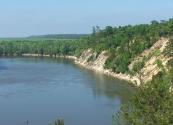


The Garden of Eden?
Florida legend holds that
Alum Bluff was the location of
the Garden of Eden.
Florida legend holds that
Alum Bluff was the location of
the Garden of Eden.
Unique and Rare Plants
A variety of extremely rare
trees and plants grow in the
Apalachicola Bluffs and
Ravines Preserve.
A variety of extremely rare
trees and plants grow in the
Apalachicola Bluffs and
Ravines Preserve.
The Legend of the Garden of Eden - Bristol, FLorida
ExploreSouthernHistory.com - Apalachicola Bluffs and Ravines Preserve, Florida
ExploreSouthernHistory.com - Apalachicola Bluffs and Ravines Preserve, Florida

| Florida's Garden of Eden The Nature Conservancy's Garden of Eden Trail leads through the Apalachicola Bluffs and Ravines Preserve to Alum Bluff. |
Apalachicola Bluffs and Ravines
Note: The text on this page is excerpted from
the book Two Egg, Florida: A Collection of
Ghost Stories, Legends and Unusual Facts
by Dale Cox. Please click here for ordering
information.
The Garden of Eden is one of the best known
parts of the Book of Genesis. After He
created the heavens and the earth, the plants
and the animals, God created man. The first
man was named Adam and, as a place for
him to live, God created a magnificent garden:
Now the Lord God had planted a garden in
the east, in Eden; and there he put the man
he had formed. And the Lord God made all
kinds of trees grow out of the ground – trees
that were pleasing to the eye and good for
food. In the middle of the garden were the
tree of life and the tree of the knowledge of
good and evil.
Genesis, Chapter 2, verses 8-9.
The Garden of Eden was watered by a river
that flowed from four headwaters. One of
these came from a land where there was
gold, the second wound through the land of
“Cush,” the third was the Tigris and the fourth
was the Euphrates. Because God did not
think it was good for Adam to be lonely, He
created a woman named Eve to live in the
garden as well. Adam was warned, however,
that he was not to eat from the tree of the
knowledge of good and evil. If he did, he
would die.
What happened next is well known. The
serpent tempted Eve to eat of the tree of the
knowledge of good and evil and she shared
the fruit with Adam. God then drove them both
from the Garden of Eden and placed
cherubim (Angelic beings) before the
entrance to the garden and a flaming sword
that flashed back and forth to guard the tree
of life. These protected the garden until the
flood of Noah, when the Garden of Eden was
washed away.
It has long been assumed that the Garden of
Eden was somewhere in modern day Iraq.
The Tigris and Euphrates Rivers still flow
there and the region has long been called
the “Cradle of Civilization.” A more
controversial theory, however, holds that the
garden was nowhere near the Middle East.
This theory, first advanced by Bristol resident
E.E. Callaway, places the Garden of Eden on
Florida’s Apalachicola River.
For Callaway, this theory was not just a flight
of fancy. The Apalachicola is fed by four
primary tributaries or “heads,” exactly like the
river described in the Book of Genesis. In
addition, some of the rarest plants in the
world grow along the bluffs and steephead
ravines on the east side of the river between
Bristol and Chattahoochee. Among these are
both the Florida torreya and the Florida yew.
The torreya was officially discovered by
botanist Hardy Bryan Croom during the
1820s and named for Dr. John Torrey, a
famed naturalist of the time.
Locals have long called it the “stinking cedar”
for the strong odor it emits when it is bruised.
They also believe it is the famed gopher
wood from which Noah built the ark. This
legend, of course, added strength to
Callaway’s theory that he had found the
Garden of Eden.
the book Two Egg, Florida: A Collection of
Ghost Stories, Legends and Unusual Facts
by Dale Cox. Please click here for ordering
information.
The Garden of Eden is one of the best known
parts of the Book of Genesis. After He
created the heavens and the earth, the plants
and the animals, God created man. The first
man was named Adam and, as a place for
him to live, God created a magnificent garden:
Now the Lord God had planted a garden in
the east, in Eden; and there he put the man
he had formed. And the Lord God made all
kinds of trees grow out of the ground – trees
that were pleasing to the eye and good for
food. In the middle of the garden were the
tree of life and the tree of the knowledge of
good and evil.
Genesis, Chapter 2, verses 8-9.
The Garden of Eden was watered by a river
that flowed from four headwaters. One of
these came from a land where there was
gold, the second wound through the land of
“Cush,” the third was the Tigris and the fourth
was the Euphrates. Because God did not
think it was good for Adam to be lonely, He
created a woman named Eve to live in the
garden as well. Adam was warned, however,
that he was not to eat from the tree of the
knowledge of good and evil. If he did, he
would die.
What happened next is well known. The
serpent tempted Eve to eat of the tree of the
knowledge of good and evil and she shared
the fruit with Adam. God then drove them both
from the Garden of Eden and placed
cherubim (Angelic beings) before the
entrance to the garden and a flaming sword
that flashed back and forth to guard the tree
of life. These protected the garden until the
flood of Noah, when the Garden of Eden was
washed away.
It has long been assumed that the Garden of
Eden was somewhere in modern day Iraq.
The Tigris and Euphrates Rivers still flow
there and the region has long been called
the “Cradle of Civilization.” A more
controversial theory, however, holds that the
garden was nowhere near the Middle East.
This theory, first advanced by Bristol resident
E.E. Callaway, places the Garden of Eden on
Florida’s Apalachicola River.
For Callaway, this theory was not just a flight
of fancy. The Apalachicola is fed by four
primary tributaries or “heads,” exactly like the
river described in the Book of Genesis. In
addition, some of the rarest plants in the
world grow along the bluffs and steephead
ravines on the east side of the river between
Bristol and Chattahoochee. Among these are
both the Florida torreya and the Florida yew.
The torreya was officially discovered by
botanist Hardy Bryan Croom during the
1820s and named for Dr. John Torrey, a
famed naturalist of the time.
Locals have long called it the “stinking cedar”
for the strong odor it emits when it is bruised.
They also believe it is the famed gopher
wood from which Noah built the ark. This
legend, of course, added strength to
Callaway’s theory that he had found the
Garden of Eden.

The Florida Torreya
One of the rarest trees in the
world, the Florida Torreya
grows along the Apalachicola
Bluffs and Ravines.
One of the rarest trees in the
world, the Florida Torreya
grows along the Apalachicola
Bluffs and Ravines.



Apalachicola Bluffs and Ravines
The Florida Torreya
Torreya State Park
The Apalachicola River
Apalachicola, Florida
Historic Sites in Florida
Explore other Southern Historic Sites
The Florida Torreya
Torreya State Park
The Apalachicola River
Apalachicola, Florida
Historic Sites in Florida
Explore other Southern Historic Sites
Callaway’s ideas about the Garden of Eden
caught on, particularly in and around Bristol.
The story became widely known throughout
the area and some true believers went so far
as to erect informational signs at Alum Bluff,
out locations where Adam might have met
Eve, where the Tree of Life grew and more.
The signs no longer exist today, but
photographs of them can be found in the
Florida State Archives.
The site identified by E.E. Callaway as the
Garden of Eden is protected today as part of
The Nature Conservancy’s Apalachicola
Bluffs and Ravines Preserve. Accessible via
Garden of Eden Road, the preserve has paid
tribute to the local legend by labeling a
primary trail leading through the site as the
Garden of Eden Trail. Be aware though, this
is not a walk for the faint of heart.
The trail leads from a parking lot and
informational kiosk near Highway 12 to the
crest of Alum Bluff, a walk of 3.75 miles,
much of it up and down. The scenery,
however, is spectacular. Clear, bubbling
streams flow through the bottoms of the
steephead ravines. There are rare plants and
animals, some of which are found nowhere
else in the world. And at the end of the trail is
Alum Bluff, a magnificent elevation that
provides what may be the best view in all of
Florida. Towering 135 feet above the
Apalachicola River, the bluff is believed to be
the largest exposed section of the earth’s
crust in Florida.
The trail guide map, available at the kiosk,
provides information on the uniqueness of
the setting and also points out the site where
Callaway believed the Garden of Eden once
existed.
caught on, particularly in and around Bristol.
The story became widely known throughout
the area and some true believers went so far
as to erect informational signs at Alum Bluff,
out locations where Adam might have met
Eve, where the Tree of Life grew and more.
The signs no longer exist today, but
photographs of them can be found in the
Florida State Archives.
The site identified by E.E. Callaway as the
Garden of Eden is protected today as part of
The Nature Conservancy’s Apalachicola
Bluffs and Ravines Preserve. Accessible via
Garden of Eden Road, the preserve has paid
tribute to the local legend by labeling a
primary trail leading through the site as the
Garden of Eden Trail. Be aware though, this
is not a walk for the faint of heart.
The trail leads from a parking lot and
informational kiosk near Highway 12 to the
crest of Alum Bluff, a walk of 3.75 miles,
much of it up and down. The scenery,
however, is spectacular. Clear, bubbling
streams flow through the bottoms of the
steephead ravines. There are rare plants and
animals, some of which are found nowhere
else in the world. And at the end of the trail is
Alum Bluff, a magnificent elevation that
provides what may be the best view in all of
Florida. Towering 135 feet above the
Apalachicola River, the bluff is believed to be
the largest exposed section of the earth’s
crust in Florida.
The trail guide map, available at the kiosk,
provides information on the uniqueness of
the setting and also points out the site where
Callaway believed the Garden of Eden once
existed.

River that Watered Eden?
E.E. Callaway's theory pointed
to the similarity of the
Apalachicola River system to
the Biblical description of the
rivers of Eden.
E.E. Callaway's theory pointed
to the similarity of the
Apalachicola River system to
the Biblical description of the
rivers of Eden.

Florida Torreya
The best place to see Florida
Torreya trees growing is
nearby Torreya State Park,
just up the road from the
Apalachicola Bluffs and
Ravines Preserve.
The best place to see Florida
Torreya trees growing is
nearby Torreya State Park,
just up the road from the
Apalachicola Bluffs and
Ravines Preserve.





Custom Search
| Copyright 2011 by Dale Cox All rights reserved. |